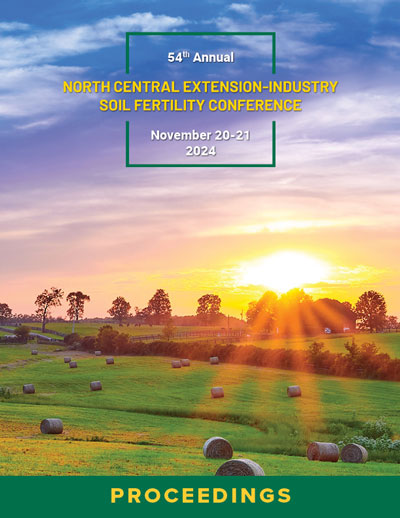Download the
Conference Proceedings
Proceedings
Authors
| Filter results6 paper(s) found. |
|---|
1. A Crop-Based Approach for In-Season N Management of CornOver-application of nitrogen (N) fertilizer on corn has resulted in elevated levels of N in ground and surface waters. A major factor contributing to decreased N use efficiency and environmental contamination for traditional corn N management schemes is routine pre-season application of large doses of N before the crop can effectively utilize this N. Our long-term research goal is to reduce these over-applications by using remote sensing to direct fertilizer only to areas needing N at times when... |
2. Corn, Soybean, and Alfalfa Response to Dolomitic and Calcitic LimeCenewed interest in soil pH and liming on some of south-central Minnesota's rnost productive glacial till soils has occurred recently because: (1) intensive "grid" soil sampling has identified areas of fields that are generally considered below optimum pH ( (2) the availability of site-specific application technology to treat only below-optimum pH soils in fields that contain significant variability in soil pH, and (3) near neutral pH is believed to be necessary for achieving exceptionally high yields.... |
3. Nitrous Oxide Emissions From Nitrogen Fertilizers In IllinoisNitrous oxide (N 2O) has a large global warming potential (GWP). Agricultural applications of nitrogen (N) contribute to N 2O emissions but it might be possible to mitigate such emissions through different N sources. We investigated the potential for anhydrous ammonia (AA), urea, and polymer coated urea (ESN) to mitigate N 2O emissions while enhancing corn (Zea mays L.) production. This three-year study was conducted in Champaign County, Illinois on highly productive mollisols during 2009 to 2011.... |
4. Evaluation of Weed Management Strategies on Grain Sorghum Nitrogen Status and Grain Yield Using Optical SensorsInformation on weed management options and relation to nutrient status is very limited for grain sorghum production. The objectives of this study were: (i) determine the effects of different weed management strategies on grain sorghum yield; and (ii) evaluate the impact on nitrogen (N) status and development of the crop. This study was established at two locations in 2014 (Smith and Reno Co in Kansas). The study used a randomized complete block design with 4 replications. Two main factors evaluated... |
5. Response of Corn to Residue Management and Nitrogen FertilizationInterest in the production of cellulosic fuel production for bioenergy has identified corn (Zea mays L.) as a suitable option. However, residue removal can affect the growth and yield of a following corn crop and its response to N fertilizer. Residue removal may also influence the optimal tillage system with regard to yield and N-use efficiency. In southern Minnesota, concern about yield reductions due to cool, wet soil conditions, partially attributed to high amounts of crop residue, have limited... |
6. Tile Drainage, Cover Crops and Nitrogen InteractionsPrevious research has shown subsurface tile drainage systems deliver nitrate-N to surface waters thereby degrading water quality. Cover crops and applying appropriate N rates for corn are potential management strategies for reducing NO3-N in tile drainage. The objective of this study was to measure the effects and interactions of cover crops (winter hardy and winter terminating) at various N rates on NO3-N concentration and load in tile drainage water and corn and soybean... |
